The largest and most confusing assemblage among the shearwaters and petrels of the world is the genus Pterodroma, the gadfly petrels. Pterodroma petrels range throughout the warmer waters of the world, but before our pelagic trip on Hauraki Gulf I had had little chance to encounter them. Those I had seen appeard only at a considerable distance - once, of all places, from the Lake Erie shoreline in Ontario, where I watched hurricane-blown Black-capped Petrels (Pterodroma hasitata) hunting over the barren waters in a vain search for food, a few days before their starved bodies washed up on the beach.
Hauraki Gulf changed all that. Here, swarms of the most abundant gulf gadfly, Cook's Petrel (Pterodroma cookii), surrounded our boat, and we were visited by individuals of at least two - or, more likely, three - other species.
Cook's Petrel is - almost - another Hauraki Gulf breeding specialty. I say "almost", because besides breeding on Great and Little Barrier Islands in the gulf, it also breeds far to the south on the Codfish Islands, west of Stewart Island. Though the population is well over a million birds, it is in decline.
Like other petrels breeding in the gulf, Cook's ranges widely across the Pacific in the off season, reaching the western coast of North America. It was strange to realize, as we sailed the gulf waters, that so many seabirds that cover so much of the Pacific breed only here. Hauraki Gulf is really Seabird Central - and I can only hope it stays that way.
Cook's Petrel is - almost - another Hauraki Gulf breeding specialty. I say "almost", because besides breeding on Great and Little Barrier Islands in the gulf, it also breeds far to the south on the Codfish Islands, west of Stewart Island. Though the population is well over a million birds, it is in decline.
Like other petrels breeding in the gulf, Cook's ranges widely across the Pacific in the off season, reaching the western coast of North America. It was strange to realize, as we sailed the gulf waters, that so many seabirds that cover so much of the Pacific breed only here. Hauraki Gulf is really Seabird Central - and I can only hope it stays that way.
Cook's Petrel gives it name to a complex of small gadfly petrels, the members of the subgenus Cookilaria. Cookilarias are crisply patterned in black, grey and white, differing from each other in subtle details of shape, pattern and flight style, and can be a nightmare to identify.
Cook's Petrel itself (like many of its near relations) is highly variable - compare the extent and darkness of the grey on the head and the underside of the primaries on these two birds. We studied (as best we could) any darker individuals that flew past us in the hope of finding a much rarer species, Pycroft's Petrel (Pterodroma pycrofti).
Pycroft's has a slightly more extensive hood and shorter bill than Cook's, but spotting this at sea is no easy task. In the end, our guides did call one bird that flew quickly past us (far too quickly for me to get a decent photo, though others managed) a Pycroft's. I would have needed a lot more experience to make such a call myself, but I saw what they were talking about.
Pycroft's has a slightly more extensive hood and shorter bill than Cook's, but spotting this at sea is no easy task. In the end, our guides did call one bird that flew quickly past us (far too quickly for me to get a decent photo, though others managed) a Pycroft's. I would have needed a lot more experience to make such a call myself, but I saw what they were talking about.
A far easier call was our one other Cookilaria, a very handsome bird indeed: a Black-winged Petrel (Pterodroma nigripennis) that flew by us in the afternoon. For once, this is not a Hauraki Gulf specialist; it breeds widely in the southwest Pacific, with the bulk of its New Zealand breeding population further north, in the Kermadec Islands.
The broad black stripe on the underside of its wing distinguishes it easily from Cook's Petrel.
Our fourth Pterodroma for the day was very different, a much larger and more heavily-built bird than the three Cookilarias: the Grey-faced Petrel (Pterodroma macroptera gouldi), the New Zealand subspecies of the Great-winged Petrel (Pterodroma macroptera), sometimes considered a species in its own right.
The broad black stripe on the underside of its wing distinguishes it easily from Cook's Petrel.
Our fourth Pterodroma for the day was very different, a much larger and more heavily-built bird than the three Cookilarias: the Grey-faced Petrel (Pterodroma macroptera gouldi), the New Zealand subspecies of the Great-winged Petrel (Pterodroma macroptera), sometimes considered a species in its own right.
The Grey-faced Petrel may do a lot of its feeding by night. The squid and fish that it seems to prefer normally do not come closer than 150 m to the surface by day, according to a 1973 study of the bird's feeding habits by M. J. Imber.
This bird, though, seemed quite happy to drop by our boat for a daytime snack.
Its obvious grey face and broad-winged, blunt profile make the Grey-faced Petrel fairly easy to tell from the other dark petrels and shearwaters of the gulf.
Our final bird for this posting, here circling around the Grey-faced Petrel, is not a Pterodroma but a prion, a member of a petrel genus (Pachyptila) whose members are, perhaps, even harder to tell apart than the Cookilarias.
I say "perhaps because I have only ever seen one: this one, the Fairy Prion (Pachyptila turtur).
In contrast to the Hauraki Gulf specialists we encountered on our trip, the Fairy Prion is one of the most widespread and abundant seabirds in the Southern Hemisphere, with an estimated population of some five million birds.
The various prions are almost identical in plumage, differing largely in the size and shape of the bill. They are small birds, and take smallish prey - mostly krill - which they pick daintily from the surface, often while in flight.
In my next posting I will turn to two even smaller seabirds - including the species that, more than any other, sets Hauraki Gulf birders' hearts a-flutter.
I say "perhaps because I have only ever seen one: this one, the Fairy Prion (Pachyptila turtur).
In contrast to the Hauraki Gulf specialists we encountered on our trip, the Fairy Prion is one of the most widespread and abundant seabirds in the Southern Hemisphere, with an estimated population of some five million birds.
The various prions are almost identical in plumage, differing largely in the size and shape of the bill. They are small birds, and take smallish prey - mostly krill - which they pick daintily from the surface, often while in flight.
In my next posting I will turn to two even smaller seabirds - including the species that, more than any other, sets Hauraki Gulf birders' hearts a-flutter.

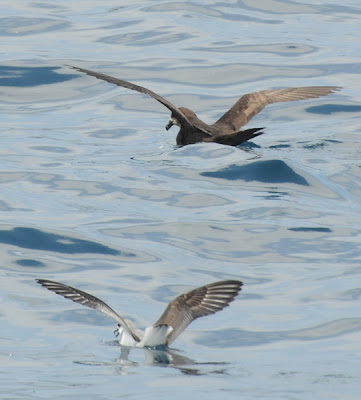
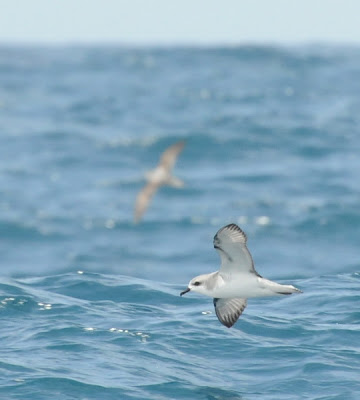





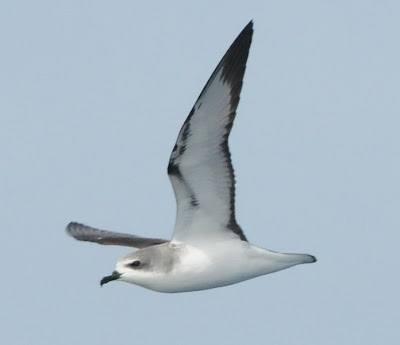



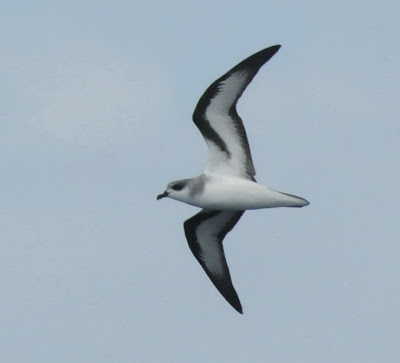












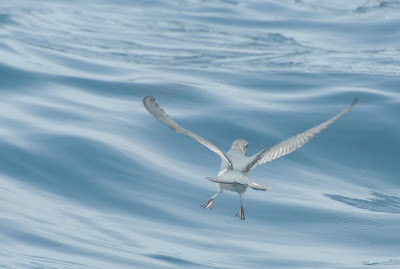

No comments:
Post a Comment